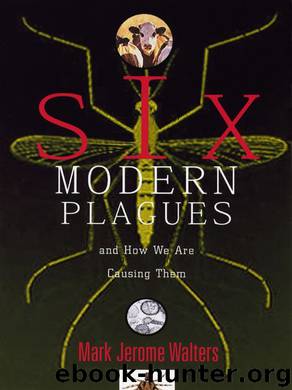Six Modern Plagues and How We Are Causing Them by Mark Jerome Walters

Author:Mark Jerome Walters
Language: eng
Format: epub
ISBN: 9781597266260
Publisher: Island Press
Published: 2012-09-11T16:00:00+00:00
6.
The year 1997 saw one of the most prolific acorn crops in the mid-Atlantic states in years. In Hutcheson Memorial Forest, Edmund Stiles recalled the abundance of acorns that year. Moving through the forest, he said, was “like walking on marbles.” Perhaps no place experienced a greater rain of the acorns than the beautiful, oak-arched campus of Drew University in Madison, New Jersey. The campus is situated in a grove of old oaks, many of them towering a hundred feet overhead. The school has been called the “university in the forest.”
Twenty-year-old Jeff Dunbar was a sophomore in the fall of 1997, and so many acorns pummeled his dorm roof that term that the noise sometimes woke him at night. By day, deer from a nearby forest wandered across campus, and chipmunks, squirrels, and mice scurried amid the landscaping at the building’s foundations. The presence of so many deer on campus that fall meant that numerous egg-laden ticks were falling to the ground. And two years later—by the summer of 1999—these led to a population explosion of blood-hungry nymphs. That happened to be the very summer Dunbar decided to live on campus while working for a state assemblyman nearby. Dunbar played Frisbee on campus almost every evening, and wayward throws often sent him scrambling through tick-laden bushes.
On August 1, Dunbar awoke with the left side of his face paralyzed. He went to the emergency room at nearby Morristown Memorial Hospital, where the attending physician treated him with steroids. A Lyme test, which measures the body’s immune response to the Lyme disease bacterium, was negative. But the test can be inconclusive if the body’s immune response has not yet kicked in. The disease can therefore go undetected. His facial paralysis disappeared two weeks later without further treatment.
He continued his job into the winter of 2000. That February, as he was stuffing mailings into envelopes, his shoulders and elbows became so stiff and sore that he could hardly move them. His physician concluded that the repetitive stuffing motion had strained both shoulder joints, and he recommended physical therapy. Dunbar improved, but he still felt tired and sore. During the summer of 2001, as he was undergoing routine arthroscopic surgery for a slight tear in a knee ligament, his surgeon discovered severe inflammation in the joint. A Lyme test ordered by the surgeon was positive. By now, the bacteria had invaded Dunbar’s joints and spinal fluid. After eight weeks of intravenous antibiotics, he improved, and his symptoms largely disappeared.
Meanwhile, Ostfeld had gathered data on the rate of Lyme disease in the mid-Atlantic states, where a large acorn mast had occurred two years earlier. If his theory was correct, the rate of infection should rise among people there in the second year after the mast. The 1999 infection rate did increase in the area affected by the mast of 1997. In fact, 1999, the year Dunbar became ill, saw the third-highest number of Lyme disease cases ever reported in the mid-Atlantic region.
Download
This site does not store any files on its server. We only index and link to content provided by other sites. Please contact the content providers to delete copyright contents if any and email us, we'll remove relevant links or contents immediately.
Periodization Training for Sports by Tudor Bompa(8215)
Why We Sleep: Unlocking the Power of Sleep and Dreams by Matthew Walker(6659)
Paper Towns by Green John(5141)
The Immortal Life of Henrietta Lacks by Rebecca Skloot(4552)
The Sports Rules Book by Human Kinetics(4348)
Dynamic Alignment Through Imagery by Eric Franklin(4178)
ACSM's Complete Guide to Fitness & Health by ACSM(4020)
Kaplan MCAT Organic Chemistry Review: Created for MCAT 2015 (Kaplan Test Prep) by Kaplan(3972)
Introduction to Kinesiology by Shirl J. Hoffman(3744)
Livewired by David Eagleman(3730)
The Death of the Heart by Elizabeth Bowen(3580)
The River of Consciousness by Oliver Sacks(3573)
Alchemy and Alchemists by C. J. S. Thompson(3483)
Bad Pharma by Ben Goldacre(3397)
Descartes' Error by Antonio Damasio(3249)
The Emperor of All Maladies: A Biography of Cancer by Siddhartha Mukherjee(3114)
The Gene: An Intimate History by Siddhartha Mukherjee(3075)
The Fate of Rome: Climate, Disease, and the End of an Empire (The Princeton History of the Ancient World) by Kyle Harper(3035)
Kaplan MCAT Behavioral Sciences Review: Created for MCAT 2015 (Kaplan Test Prep) by Kaplan(2959)
